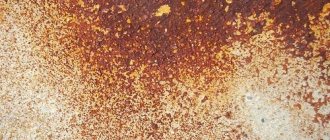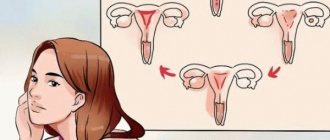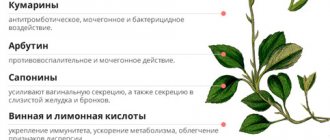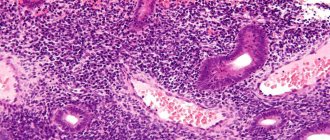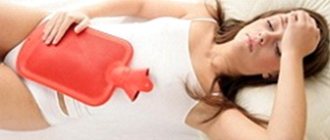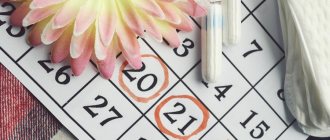“I was cleaned” or “I was cleaned” - I often hear these phrases from my patients, and they sound to me as unbearable as the movement of foam plastic on glass. We colloquially call “cleaning” curettage of the uterus - the most common procedure performed in gynecology in the vast majority of cases without any indication for it.
This very established name - “cleaning” - already reflects a rough, clumsy and primitive approach to solving the problem. By the way, the term smoothly passed from medical jargon into the vocabulary of many women who even believe that they need to “get clean” or “get clean” from time to time. Perhaps they put the same meaning into this as the notorious “cleansing the body of toxins,” suggesting that “dirt” accumulates in this organ too.
Before continuing the story, it is necessary to explain what exactly we are talking about.
After curettage of the uterus: possible risks
Curettage is an outpatient medical procedure performed under intravenous anesthesia, during which the uterine mucosa is removed (scraped) using a special curette. The procedure is called therapeutic and diagnostic, since it removes disease-modified tissue (if any), which can be examined under a microscope and an accurate diagnosis made. From the previous sentence it is clear that curettage is carried out not only in the presence of a disease, but when it is suspected, that is, for the purpose of making a diagnosis.
So far everything is clear, logical and obvious. However, there is another side to this manipulation. The procedure is performed with a sharp iron curette, with the help of which the mucous layer of the uterus is actually “torn off”, and inevitable injury to the uterus itself occurs. As a result, there is a risk of several serious complications: damage to the growth layer of the endometrium (impairing its growth in the future), the appearance of adhesions in the uterine cavity, and the development of inflammation.
In addition, this procedure contributes to the development of a disease such as adenomyosis (endometriosis of the uterus) - due to the violation of the boundary between the layers of the uterus, which contributes to the growth of the endometrium into the muscle of the uterus. As a result, curettage may lead to problems with conception or trigger the development of adenomyosis.
It is quite obvious that such a procedure must be done strictly according to indications and the benefit-risk ratio must be seriously assessed. But this is possible anywhere, but not here, and this is very sad.
Fertility Cleanse With Herbs
Fertility Cleansing with Herbs to normalize the functionality of the reproductive system and help prepare for conception.
I'm not really into cleaning. I’ve probably had 2 of them in my entire life. The very first one was a tough one, it was a juice cleanse for 5 days! Where I drank only juices and thought that I would kill everyone around me. And then I realized that this kind of cleansing of the body was definitely not for me.
I think each of you has heard, for example, about colon cleansing as a way to detoxify the body. All kinds of body cleansing have existed for thousands of years. They have been used to keep the body healthy and can be one of the healthiest things you can do as you prepare for pregnancy.
The time before conception is very important to create a healthy body ready to carry a pregnancy. This is the ideal time to cleanse your liver and uterus.
Gentle and gentle cleansing with natural herbs stimulates the liver to remove toxins and unnecessary hormones accumulated in our body.
Fertility cleansing supports the normal function of the uterus, clears it of stagnant menstrual blood, improves blood circulation and strengthens the walls of the uterus.
I completed one Fertility Cleanse course a couple of months ago and now I can share my personal experience.
This cleansing will come in handy for those who are preparing to conceive, suffer from infertility, have suffered a miscarriage, or are struggling with inflammatory diseases of the female organs.
Fertility Cleanse with Herbs: why do it?
Over the years, our body accumulates toxins. There is hardly a person who, from birth, ate what he needed, led a healthy lifestyle and lived in ideal environmental conditions. Many toxins are firmly lodged in our fat tissue and we must help our body get rid of them.
Deposition of toxins is caused by:
- taking birth control pills or undergoing hormone therapy
- smoking
- alcohol consumption
- pesticides
- poor nutrition
- hormonal imbalance
- use of unnatural cosmetics
- toxic household chemicals
Fertility Cleansing is designed specifically for the reproductive system and helps get rid of the so-called unnecessary “slag”. It consists of 2 stages: cleansing the liver and cleansing the uterus.
Liver Health
The liver is our main organ of detoxification or cleansing. It removes toxins and hormones we don’t need, often the female hormone Estrogen. And like any other part of our body, it really needs support!
Uterine health
The uterus is very important for reproductive health. Each menstrual cycle, our uterus must be freed from a special layer of cells built for embryo implantation. Sometimes the uterus is not completely cleansed and particles of this epithelium or blood remain in it.
This can be facilitated by:
- poor blood circulation
- hormonal disbalance
- poor nutrition
Cleaning maintains the health of the uterus, improves blood circulation and lymph flow, and helps strengthen the uterine muscles.
Should you do a Fertility Cleanse?
Do you have one or more of the following conditions?
- PMS
- unexplained fatigue
- took birth control pills
- acne
- go to the toilet irregularly "too much"
- dark circles under the eyes
- have been taking medications or antibiotics for more than 1 week
- dark clots during menstruation
- hormonal imbalance
- frequent colds
- infertility
- miscarriage
- inflammatory processes of the reproductive system
Herbal liver cleanse or 1 part Fertility Cleanse
Liver cleansing with herbs should be done from the first day after menstruation ends and before ovulation begins. This is the so-called “stimulating” part of the cycle, ideal for encouraging liver function.
First we need to purchase the herbs with which we will carry out Fertility Cleansing. To do this, I advise you to visit a herbal pharmacy.
Herbs for cleansing the Liver:
Dandelion root is rich in vitamins and minerals, supports digestion and helps with liver function.
Burdock root stimulates digestion, nourishes and cleanses our main detoxifying organ.
Milk thistle seeds or the best medicine for our liver. Contains special substances Silimarim and Silybin , antioxidants that regenerate liver cells and increase the synthesis of Glutathione, which in turn is necessary for its normal functioning.
Ginger Root – Improves circulation, supports normal inflammatory response and detoxification function.
Ingredients:
- Filtered water – 500 ml
- Dandelion root - 1 tablespoon
- Burdock root - 1 tablespoon
- Milk thistle seeds (powder) - 1 tablespoon
- Ginger root, fresh - 1 cm
Cooking method:
- We put all our herbs and ginger in a small teapot.
- Fill with hot water and leave for 30 minutes.
Mode of application:
Drink this infusion throughout the day.
How to determine Ovulation?
There are 2 ways.
If your cycle is constant and not prone to change (and I consider you very lucky), then all you need to do is count 17 days ago from the first day of your expected period. That is, for example, my next period should begin on October 31 minus 17 equals 14. That is, my ovulation will occur on October 14.
If your cycle is not constant or it fluctuates, then you will need to go to the pharmacy and buy an ovulation test. Usually it comes in a set of 5. And start testing 20 days before the start of your expected menstruation, or better yet, 22 days. I must say right away that this will not be cheap.
I will write about another method, which does not require costs, but a lot of detailed explanation, in one of the subsequent posts.
Cleansing the Uterus with Herbs or Part 2 of Fertility Cleansing
Cleaning the uterus must be carried out from the moment of ovulation until the first day of menstruation. This is the so-called “construction” part of the menstrual cycle.
Herbs for cleansing the uterus:
Licorice root is an adaptogen that supports normal function of the endocrine system.
Raspberry leaves tones the muscles of the uterus and normalizes blood flow during menstruation. Considered one of the best herbs for the female reproductive system.
The boron uterus normalizes female hormones, increases the likelihood of conception and reduces the likelihood of miscarriage.
The red brush helps restore hormonal balance, normalizes the menstrual cycle, and eliminates inflammatory processes.
Nettle contains large amounts of Chlorophyll, vitamins and minerals. Supports kidney and adrenal health.
Important:
- This cleansing should be done at least once before conception.
- Cleaning should not be performed during pregnancy or breastfeeding.
- You should refrain from trying to conceive during the Fertility Cleanse.
- You cannot use these cleanses if you are on any hormonal contraceptives.
- Consult your healthcare professional before starting to use herbs.
- Remember to combine the Fertility Cleanse with Castor Oil compresses on the liver area (during a liver cleanse) and on the lower abdomen or uterus area (during an herbal uterine cleanse).
What kind of Fertility Cleansing may you have done?
(Visited 8,026 times, 1 visits today)
Source: https://happyandnatural.com/fertilnaya-chistka-travami/
Scraping “just in case”
I think that in more than 80% of cases, curettage is carried out in vain, that is, either without any indication at all, or in cases where the problem can be solved with medication or through a simple outpatient procedure.
Here are situations in which you may be asked to perform curettage.
- You have been bleeding for a long time or have uterine bleeding.
- An ultrasound revealed that you have an endometrial polyp, endometrial hyperplasia, adenomyosis, uterine fibroids, or chronic endometritis.
- You are planning to undergo surgical treatment for uterine fibroids.
- You suspect an ectopic pregnancy.
- You complained that you have heavy menstruation, intermenstrual spotting or brown “spotting” before and/or after menstruation.
In general, people are sent for “cleaning” very often, even in the absence of the reasons that I listed above. Curettage often accompanies any surgical treatment in gynecology. It’s as if they are always trying to do it “at the same time”, in order to “check, just in case,” whether everything is normal. It shouldn’t be this way; this is too frivolous an attitude towards a rather traumatic procedure.
Manual removal of residues and massage
As you already know, every woman who gives birth undergoes an ultrasound. During the examination, the doctor can determine the location of the lumps of mucus. If there is a clot in the uterus, massage is performed after childbirth. Its purpose is to strengthen the contractility of the reproductive organ to push out mucus. Massage is performed every 2-3 hours. The doctor presses on the lower abdomen, pushing the clots toward the mouth of the uterus. The procedure is considered quite painful, but it cannot be avoided.
Gynecologists also use manual separation of clots. The os of the uterus in the first three days after birth is open by 8-12 centimeters. This distance allows you to easily carry out manipulation without using expanders.
When not to agree to scraping
So, instructions on how to avoid scraping .
- If you do not have heavy uterine bleeding (as they say, “it pours down your legs”), but just prolonged bleeding and pregnancy (uterine and ectopic) is excluded, ask your doctor about the possibility of stopping the bleeding with medication. Yes it is possible. While taking the drug (I will immediately warn you that this is a hormonal drug, but it is safe), the bleeding may stop, and your condition will need to be re-evaluated after the next menstruation. In many cases, the treatment provided will be sufficient and nothing more will need to be done.
- If during an ultrasound you are found to have a polyp or endometrial hyperplasia, do not rush to agree to curettage. Ask your doctor about the possibility of prescribing the drug for you this cycle and then repeat the ultrasound after the end of the next menstruation. If a polyp or hyperplasia is confirmed, alas, curettage must be done under hysteroscopy control. But you have a very high chance that after menstruation there will be no indication for the procedure.
A polyp is a growth on the lining of the uterus (looks like a finger or mushroom), most often benign. There are polyps that are rejected during menstruation, and those that grow from the germ layer. The latter require removal.
Hyperplasia is a thickening of the mucous membrane of the uterine cavity. There are two types: simple and complex. Simple hyperplasia occurs most often, it is not dangerous, for its development there must be a mandatory reason (functional cyst in the ovary, polycystic ovary syndrome and several more). Usually, 10 days of taking the drug is enough for it to go away and not recur.
Complex hyperplasia - bad hyperplasia, an error in the structure of the endometrium, usually occurs after 35 years, more often against the background of excess body weight. It is treated first by removing the mucous membrane (scraping) and then by a multi-month course of hormonal drugs or by installing a Mirena intrauterine hormonal device. An accurate diagnosis is only possible with histological examination.
- If you are asked to do curettage only for diagnostic purposes before surgery or to clarify the condition of the mucous membrane, ask the doctor to start with an endometrial biopsy (also called a “pipe biopsy” or “aspiration biopsy”). This is a simple outpatient procedure that does not require any anesthesia. A thin tube is inserted into the uterine cavity and a small amount of tissue is sucked in, which is then sent to the laboratory for examination. This is a fairly informative analysis.
Important: the material obtained as a result of curettage or biopsy is only the mucous membrane of the uterus; it does not carry any information about other diseases. The fact is that curettage is often prescribed for the purpose of assessing uterine fibroids for its characteristics; So, scraping will not give any information.
- Remember, almost all modern ultrasound machines allow you to evaluate the uterine mucosa and identify signs of pathology in it. If the doctor writes during an ultrasound that the endometrium is not changed, and you do not have heavy menstruation or intermenstrual bleeding, then the likelihood that you have a pathology that requires curettage is close to zero.
- In general, the main manifestations of endometrial pathology (curettage is aimed only at this tissue) are bleeding, heavy menstruation and intermenstrual spotting. Thus, if you do not have this, discuss with your doctor whether his desire to perform curettage is justified.
- “Chronic endometritis” is a common diagnosis on ultrasound and in the results of histological findings after curettage. We are talking about chronic inflammation of the uterine mucosa. However, there are no generally accepted criteria for making this diagnosis using ultrasound in evidence-based medicine . Simple histology also cannot reliably confirm this diagnosis . Often this diagnosis is made where it does not exist, since they focus on “leukocytes”.
A reliable diagnosis is possible only by conducting a special type of study - immunohistochemistry. This study is not available in all laboratories, and the material for it can be obtained by biopsy rather than by curettage. I think it is now clear that curettage is not necessary to confirm the diagnosis of chronic endometritis. In general, the diagnosis and treatment of this endometrial disease makes sense only within the framework of the problem of infertility and miscarriage.
Drug treatment: drugs
If a clot is found in the uterus after childbirth, the woman must be prescribed drugs that enhance the contraction of the muscular organ. Most often these are Oxytocin, Hyfotocin, Dinoprost, Ergotal and others. Some maternity hospitals practice the prophylactic use of the described remedies. But the attitude of doctors towards this approach is ambiguous.
In addition to medications that contract the uterus, the woman is prescribed antibacterial drugs. At the same time, the issue of the possibility of further breastfeeding is resolved. The opinions of gynecologists differ here. Some experts believe that it is necessary to take antibiotics in order to prevent the inflammatory process. Other doctors say that breastfeeding should be continued because it helps the uterus contract naturally.
If a pathology is detected, it is prohibited to take antispasmodics that relax muscles.
In what situations should you agree to scraping?
- Heavy uterine bleeding: yes, curettage is a way to stop it.
- Suspicion of ectopic pregnancy (difficulty in making a diagnosis).
- Polyp or endometrial hyperplasia that has not disappeared after menstruation or drug treatment.
- Remains of membranes (after abortion, miscarriage, pregnancy).
- Any spotting after menopause.
Now, I hope you have reliable instructions on how to avoid possibly unnecessary surgery for you. Don't be afraid to ask your doctor questions. Offer alternatives (endometrial biopsy, medication). Ask to justify the need for curettage. The answer “that’s how it is with us” should not be accepted. Of course, all this applies only to those situations in which there is no threat to your life and health (excessive bleeding).
Folk remedies for reducing the genital organ
Is it permissible to use grandma’s recipes if there is a clot in the uterus? After childbirth, taking various herbs can be quite dangerous, since not all drugs are allowed during lactation. Many substances can cause an allergic reaction in a child. If you are not breastfeeding, you can try to get rid of the pathology with the help of herbs. But remember that gynecologists do not advise self-medication. And prolonged presence of clots in the uterus can lead to infection or sepsis.
- Nettle decoction. This plant is known to increase uterine contractility. You need to brew nettle in the amount of 4 tablespoons per half liter of boiling water. Take 100 ml infusion three times a day.
- Shepherd's purse. This herb also has the property of activating the muscle organ. Boil two glasses of water and add 4 tablespoons of herbs there. Leave until cool, strain. You need to drink this amount throughout the day.
- Blood red geranium. Take 2 teaspoons of herb and add 400 milliliters of chilled water. Leave the mixture overnight and strain in the morning. Drink throughout the day.
There is an opinion that large doses of vitamin C cause contractions of the reproductive organ. Therefore, if there is a clot in the uterus after childbirth, women try to eat foods that contain it. These are lemon, cabbage, parsley, oranges and so on.
How to deal with clots
When, despite all efforts, clots are discovered in the uterus after childbirth for a long time, treatment will not be limited to home measures. You will have to go to the doctor earlier than planned and find out the reasons for the delayed recovery of the organ.
If inflammation of the uterine mucosa has developed, due to which the discharge has acquired not only clots, but also profusion and an unpleasant odor, conservative therapy will help. These are antibiotics, antihistamines, vitamins, immunomodulators. The entire range of drugs is recommended by a specialist.
If decreased uterine tone is detected, a course of hormones that stimulate its rise is prescribed. These are “Oxytocin”, “Pituitrin”, which can help expel tissues retained in it from the organ cavity.
We recommend reading the article about inflammation of the uterus after childbirth. From it you will learn about the causes of postpartum inflammation of the organ, symptoms of the problem, diagnostic methods and therapy.
Self-help for organ recovery
Since the blood in the uterus after childbirth should not stagnate and flow endlessly, the woman should help it come out and stop in a timely manner:
- Immediately after removing the placenta, place ice on the new mother’s belly to prevent excess vessels from collapsing. In the maternity hospital, if necessary, they inject Oxytocin, which stimulates uterine contractions, and hence the healing of the inner surface.
- You can prevent blood from collecting into large clots and remaining in the uterus if you move from the first day after birth and lie on your stomach several times a day. Physical activity will increase the contractions of the organ and remove excess fluid from it.
- Don't lift anything heavy. Excessive effort can cause clots and make the discharge more intense.
- Wear a bandage or tie a wide strip of fabric around your waist. This will facilitate movements, push the uterus to take the correct position, support the abdominal muscles, that is, it will not allow complications that interfere with the removal of lochia to arise.
- Put the baby to the breast more often. Lactation will mean a natural restoration of the balance of hormones, which is also important for the development of the uterus. And the feeding process itself stimulates contractions of the organ, that is, its release from unnecessary contents without delay.
- Empty your bladder frequently, despite the apparent lack of need to do so. It is also necessary to monitor the functioning of the intestines and avoid constipation. A full bladder and digestive problems lead to pressure on the uterus, pinching of blood vessels and stagnation of blood in it.
Why did clots appear?
The uterine mucosa after childbirth is a continuous bleeding wound that will heal. But first, the organ must be freed of excess tissue that supported the vital activity of the fetus during pregnancy. The largest number of them is located at the point where the placenta was fixed.
The uterus must also get rid of excess muscle cells, that is, decrease in size. Both processes occur due to its ability to contract. The organ pushes out everything unnecessary. Hence the bloody discharge, which contains not only the contents of damaged vessels, but also fragments of placental tissue and cervical mucus. They don’t come out in one day; the full process takes up to 6 – 8 weeks. Consequently, blood clots in the uterus after childbirth at first are not only completely acceptable, but even obligatory. It indicates that the organ is working normally, is being cleansed and restored.
The greatest amount of discharge is detected when the baby is feeding and when the mother begins to move more actively. At the same time, the uterus also increases contractions due to an increase in the level of oxytocin in the woman’s blood.
But large tissue particles should not be detected throughout the entire period. The wound surface becomes healthy and renewed. And the discharge normally loses a large amount of blood over time, especially clots. They acquire a light color and a uniform, mostly slimy consistency.
Summarize
If a woman develops clots in the uterus after childbirth, treatment should only be carried out by a gynecologist. Never try to get rid of mucus lumps on your own. If you are breastfeeding, it is strictly forbidden to take any medications without prior medical advice. Speedy recovery to you!
The birth of a child does not yet put an end to the trials that a young mother endures. Her reproductive system will undergo recovery, which may be difficult. Clots in the uterus after childbirth can become one of them. Although they are also observed during the normal process of organ regeneration. But how can you tell a healthy recovery from a problematic one? And what should be done to correct a situation that could become dangerous?


